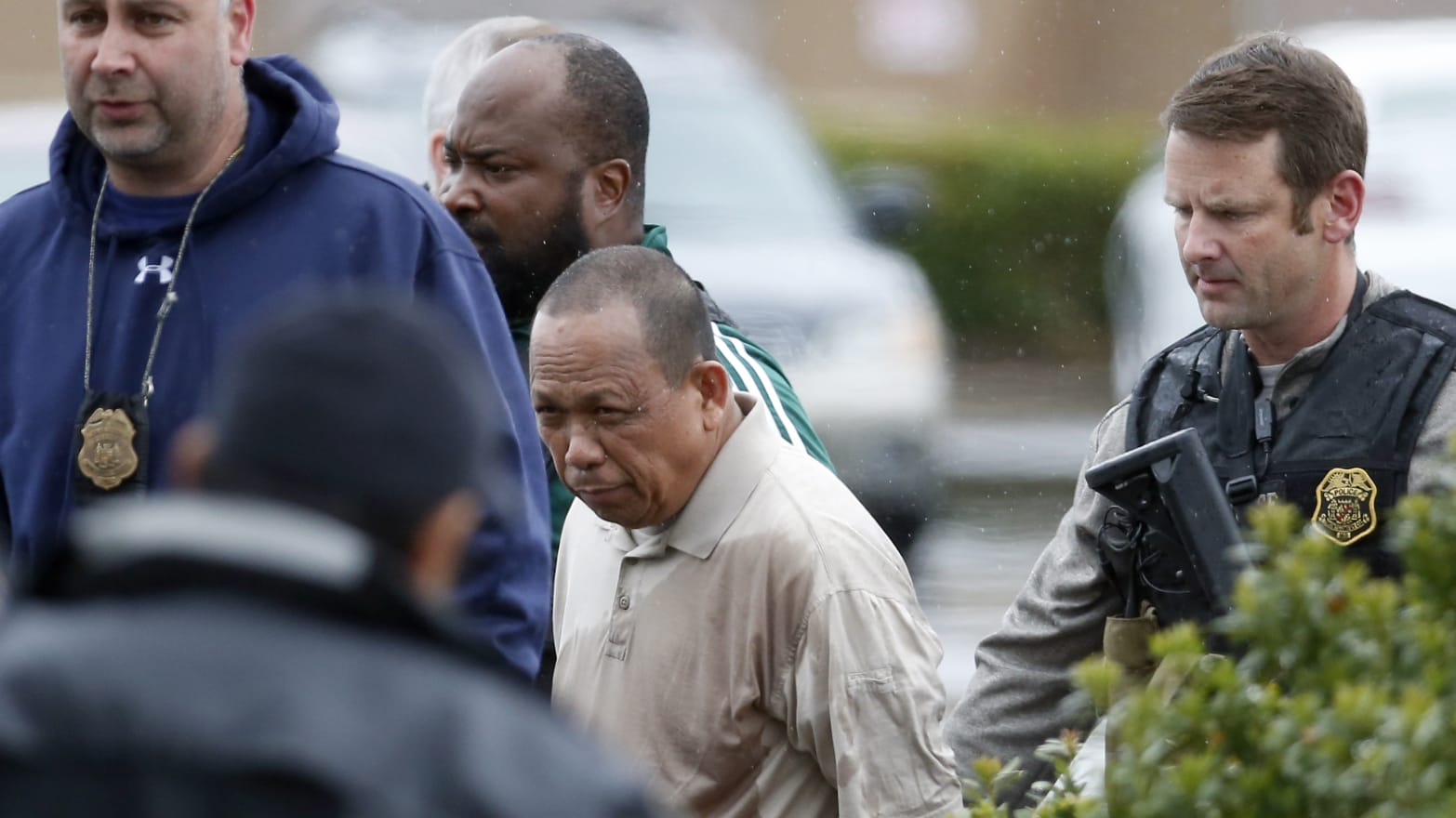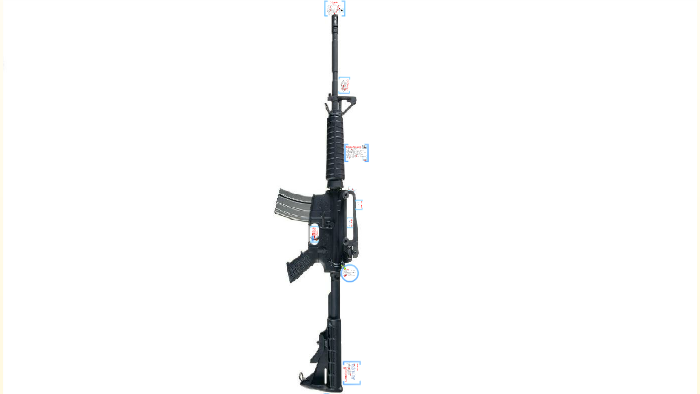The Beltway sniper attacks were a series of coordinated shootings that took place over three weeks in October 2002 in Maryland, Virginia, and Washington, D.C.. Ten people were killed and three other victims were critically injured in several locations throughout the Washington, D.C. metropolitan area and along Interstate 95 in Virginia. It was widely speculated that a single sniper, initially identified as a white man with assumed military experience, was using the Interstate 495 Capital Beltway for travel, possibly in a white van or truck. It was later learned that the rampage was perpetrated by an African-American man, John Allen Muhammad, and a minor, Lee Boyd Malvo, then aged 17 and originally from Jamaica, driving a blue 1990 Chevrolet Caprice sedan, and had apparently started in February 2002 with murders and robberies in Alabama, Arizona, California, Florida, Georgia, Louisiana, Texas, and Washington State, which resulted in seven deaths and seven injuries, bringing the total victim count to seventeen deaths and ten injuries in Alabama, Arizona, California, Florida, Georgia, Louisiana, Maryland, Texas, Virginia, and Washington State, as well as D.C.

Another Beltway sniper victim By Michelle Malkin October 27, 2006 09:31 PM Lee Malvo, one of the convicted Beltway-area snipers, has confessed to another murder: The Arizona Daily Star has more. The Beltway Sniper case relied heavily on the implementation of SAFECOM to develop communication sites between the many agencies involved. Nextel mobile devices were also used as part of this program; approximately 1,400 phones were issued between these agencies and of those, 150 were issued to the Montgomery County (MD) School Board to alert.
From October 2-22, 2002, two individuals orchestrated a series of shootings in Washington DC, Maryland and, Virginia, which resulted in the deaths of 10 people and left three critically injured. They became known as the Beltway Snipers. As a result, 27 local and state police departments, seven federal agencies, and the U.S. Department of Defense began working on the case but didn’t know where to start. [1] Local police had no leads and very little evidence. Because the shootings occurred at random and the victims weren’t connected, law enforcement had to rely on witness testimonies. Those proved to be inconsistent and inaccurate at times.
The mound of evidence collected by each agency complicated the situation because adequate communication lines had not yet been developed. With a case involving many jurisdictions, communications needed to be streamlined and organized among the agencies to better coordinate their efforts.
The Use of Technology
This is where the SAFECOM program became a necessity. SAFECOM began in early 2002 under the “President’s Management Agenda” acting under an umbrella program for the U.S. Department of Homeland Security. It oversees initiatives related to public safety communications and interoperability. Interoperability is the organization and implementation of communication devices between local, state, and federal government agencies. This allows for quick and efficient communications, regardless of an organization’s operational frequency. [2]The Beltway Sniper case relied heavily on the implementation of SAFECOM to develop communication sites between the many agencies involved. Nextel mobile devices were also used as part of this program; approximately 1,400 phones were issued between these agencies and of those, 150 were issued to the Montgomery County (MD) School Board to alert school administrators of possible threats. Mobile cell towers or Cell on Wheels (COW; shown below) were the pinnacle of technology at the time to maintain a steady connection with other agencies and to prevent lost signals or call blockages. [3]
Cell on Wheels (COW) – After-Action Report
In conjunction with the COWs, agencies deployed multi-frequency radio receiver systems (see below) that received any radiofrequency. Since departments at the time often operated on different channels, this rig allowed those frequencies to remain the same, but still communicate with each other. Radio transmissions could be rerouted and/or combined with another, regardless of their differing frequency channels.
Beltway Sniper Victims List
JPS ACU-1000 Rack Mount – After-Action Report

Trust and Cooperation
Due to the size and scope of the Beltway Sniper case, agencies had to manage vast amounts of information from all over the DC Metro area, and that meant cooperation among departments. Trust was a contributing factor when dealing with the exchange of information, but once the case was recognized as a serial case, action had to be taken to end it. However familiar some of these agencies were with their neighbors, outside agencies made them more hesitant to share information and commit to decisions being made.
[4] Trust was the major contributing factor here. The lack of familiarity within each organization, specifically that of internal contacts with one another, made communication that much more difficult.There were instances where prior relationships benefited the investigation. Special Agent in Charge Michael Bouchard of the Bureau of Alcohol, Tobacco, Firearms, and Explosives says:
“We try to build relationships with local officials whenever we can. Just four weeks before the first sniper shooting, I was in Montgomery County and met with Chief [Charles] Moose and Assistant Chief [Deirdre] Walker to discuss some joint gun investigations.” [5]
This was by no means a rarity. Many executives in the DC area spoke highly of the level of cooperation and communication prior to the Beltway Sniper case. The September 11, 2001, Pentagon attack led to a total collaboration among state, local, and federal agencies to assist with the investigation. Additionally, after September 11, executives at the local and federal levels met regularly to discuss the result of the Pentagon attack and other potential threats. By the time the Beltway Sniper case began, there were already levels of communication and cooperation established. The only change was that meetings were moved from a weekly basis to a daily basis, with multiple meetings per day in some cases. [6]As then-Chief Charles Ramsey of the Metropolitan (DC) Police Department said:
“We have close relationships in this area. It doesn’t exist like this elsewhere. People pitch in with a good degree of comfort.” [7]
Asking for Help
In addition to the help local authorities received from outside agencies, they requested even more from their community. They were now part of the case and law enforcement needed them to be aware of their surroundings and stay vigilant. Tip-lines were flooded with phone calls almost instantly, so much so that more lines were established to keep up. It wasn’t necessarily a problem with the quantity of information, even though tens of thousands of calls were received in a matter of days, but the accuracy and quality. More than 100,000 phone calls were received during the three-week case, resulting in 16,000 investigative leads. [8]One of the most misleading pieces of evidence received and dispersed by law enforcement was that a white van was thought to have sped away from multiple crime scenes. It was this bit of information that clouded the judgment of everyone involved because so much time was spent tracking this mysterious white van.
Here is a clip from the National Law Enforcement Museum’s Oral History interview with Chief Charles Moose explaining the “White Van Fallacy” [9]:
Beltway Sniper Victims List Photos
Chief Moose admits that committing to the white van tip set back the investigation, but it was necessary to accept the tip as credible, no matter how absurd it might be. Every tip needed to be carefully analyzed and researched, whether it was helpful or not. Tips were crossed off the list of possibilities and allowed authorities to move on to the next.
Law enforcement professionals faced a slew of complications during the case. Communication lacked consistency and predictability during the three weeks, but what remained strong was the ability of the agencies to learn and adapt. The multi-faceted reception of evidence made organizing key pieces of evidence and leads a demanding, fickle process. Yet, the case was solved and the two individuals responsible for the shootings were arrested 22 days after the first incident occurred. The Beltway Sniper case represents the earliest form of interoperability and shows the steady progression of decisiveness and trust among law enforcement agencies.
*************
Christopher Mitchell is Assistant Curator at the National Law Enforcement Museum. He has a Bachelor’s in History from Stetson University and a Master’s in Museum Studies from New York University.
Citations
[1] “Washington, D.C., Area Sniper Investigation,” Homeland Security Digital Library, Department of Homeland Security, September 1, 2003, ES-1, 1-2, 6.
[2] Ibid, ES-1.
[3] Ibid, 5, 9, 15-16.
[4] Murphy, Gerard R., Chuck Wexler, Heather J. Davies, and Martha R. Plotkin, Managing a Multijurisdictional Case: Identifying the Lessons Learned from the Sniper Investigation, Washington, D.C.: Police Executive Research Forum, 2004, 25.
[5] “Washington, D.C., Area Sniper Investigation,” Homeland Security Digital Library, Department of Homeland Security, September 1, 2003, 25.
[6] Murphy, Gerard R., Chuck Wexler, Heather J. Davies, and Martha R. Plotkin, Managing a Multijurisdictional Case: Identifying the Lessons Learned from the Sniper Investigation, Washington, D.C.: Police Executive Research Forum, 2004, 26.
[7] Ibid, 26.
[8] Ibid, 62.
[9] Charles Moose, Oral History Interview with the National Law Enforcement Museum.